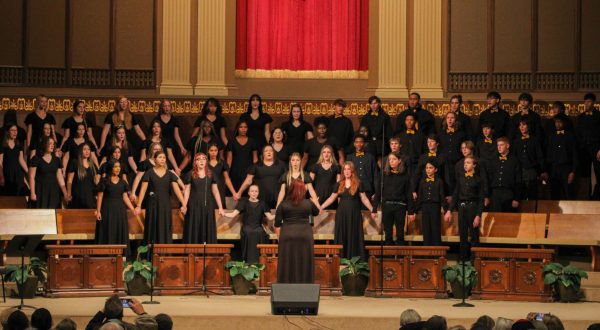School Choice, Thing of the Past
School Board begins enforcement of attendance zones throughout district
Because of the new attendance zones enforced this year by the school board, school choice for students is no longer permitted in the district, unless you are permitted an opt-out choice.
This is the first year since the mid-nineties that seventh and ninth graders have had to attend the school in their attendance zones, rather than the school of their choice.
“As far as drawing the lines, I think it helps everywhere,” Rider Principal Dee Palmore said. “You can now vertically align and help your academics, your athletics, your choirs, your bands, all of those kinds of things. To me, it creates a better situation for improvement.”
Last spring, the district hired a team specially selected to evaluate the capacity in WFISD schools. This team found a change necessary in order to provide the best possible learning environment for all students in the district, Wichita Falls High School Principal Deborah Dipprey said. The board established attendance zones according to their findings and recommendations, which have been newly enforced this school year.
“I am not sure that all the recommendations have been totally met,” Dipprey said. “But I think we are on our way to meeting them.”
Compared to last year’s student count in the different high schools at the beginning of the 2014-2015 school year, Rider has decreased by approximately 150 students, WFHS has increased by approximately 75 students and Hirschi has increased by approximately 150 students.
The fluctuations are due to the enforcements of attendance zones as well as students transferring out of the community within the past year.
The three principals at the high schools work together to make everything better.
— Dee Palmore, Rider High School Principal
“The positive thing about this is that, with a larger student population, we can offer more courses that we have not been able to in the past,” Hirschi Principal Douglas Albus said.
According to Albus, the increase in enrollment has led to a growth in Hirschi athletic and academic opportunities.
With more athletes to draw from and fuller classrooms, Hirschi has acquired a sufficient number of students in each of their different organizations, allowing them to feel less dependent upon sharing their students among their numerous school-wide activities.
Dipprey also sees the increase in students as a positive for her school.
“Certainly more students is a good thing,” Dipprey said. “We have the opportunity to have more participation in extracurricular activities. We enjoy great diversity and more students can only enhance that aspect of our campus.”
Though WFHS has gained more students, its demographics have remained about the same.
The Rider student population drop has had some negative impact to the campus.
“We don’t have as many staff members as we’ve had,” Palmore said. “When you cut staff members, you cut choices. In other words, the more students that you have, the easier it is to make your ‘master schedule’.”
We’re trying to focus on ‘How can we help Wichita Falls students?’ rather than, ‘How can we help Rider or Hirschi students?’ I think it’s been a very positive thing.
— Douglas Albus
Palmore also said there has been some loss of opportunities due to Rider’s decreased student count, such as the variety of times when a class may be offered, who is available to teach it and the number of students able to take a class in relation to how it will work with their schedule.
Although students are supposed to attend the school located in their attendance zones, some students were granted transfers in order to be able to attend the high school that successfully served their desires to excel more in certain areas.
“We have two groups of students in our high schools: the students who are still in the choice program, and the incoming classes who are now in their attendance zones,” Albus said. “The district policy is if a student is in good standing, meaning they have good attendance, no discipline issues, they have passing grades and they haven’t failed any state tests, we can transfer them. They must have a legitimate reasoning for wanting to transfer.”
Rider and WFHS are both classified as 5A high schools, while Hirschi is a 4A. These classifications are dependent upon the number of students at each high school. The classifications ensure all schools compete at an equal level on the playing field.
Hirschi differs from Rider and WFHS in a predominant way: they offer the IB program rather than AP classes. This worldwide program allows students to graduate with an IB diploma, granting them a number of hours at their choice university.
“IB is a very high level of rigor,” Albus said. “It’s a worldwide program and it really benefits our students to be a part of that.”
Though the high schools differ in many ways, the three principals strive to maintain some consistency throughout the campuses.
“The three principals at the high schools work together to make everything better,” Palmore said. “It’s not a competition. We try to improve everything.”
Though this is the first year of the enforcement of attendance zones, it is expected that over time the alignment of each middle school with a high school should prove beneficial for students, Dipprey said.
“Certainly, there have been concerns expressed regarding the change, but it has been my experience that concerns always occur when a change is made,” Dipprey said. “People, in general, can be resistant to change – even a good change.”
I truly believe that all our schools are exceptional and share a common goal – to provide the best education possible for every student.
— Deborah Dippery
The new attendance zones will heavily affect all schools in the district throughout the upcoming years.
“I think there will be some shift in the number of students at the high schools,” Albus said. “We will max out at our total number, which is around 900 students, and then I think the balance will come between the other two high schools.”
Though attendance zones haven’t been enforced in years, all three high school principals believe the zones will effectively help balance out the campuses and create a better overall situation for improvement.
“I believe schools are the same – unique because of the people who have passed through the doors over the years,” Dipprey said. “People are the school – not the building. I truly believe that all our schools are exceptional and share a common goal – to provide the best education possible for every student.”











Clayton Shotts • Nov 4, 2015 at 10:06 am
I don’t feel this is right. It’s just not right that now kids cant even choose their own schools. Whats next, choosing our schedules?